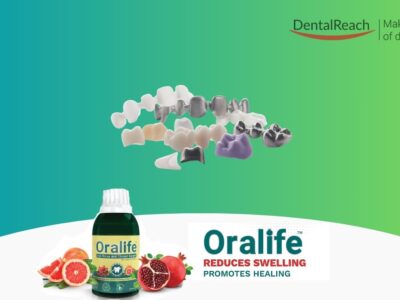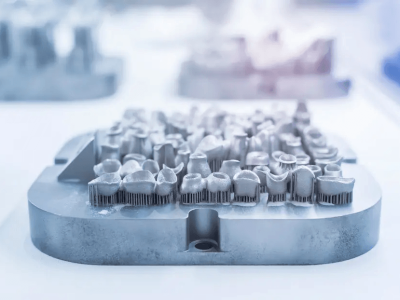Dental Labs are Overcoming Challenges Thanks to Additive Manufacturing
It has been evident for some time that the dental laboratory industry has undergone a significant transition, and more change is still to come.

It is currently estimated to be worth $31.13 billion, but Future Market Insights predicts it will increase significantly over the next few years, in part due to an ageing population.
Due to lower birth rates and longer life expectancies in the United States and around the world, the U.S. population aged 65 or older is currently growing faster than both the general population and the population under 65. Naturally, this is anticipated to increase demand in the upcoming years for a variety of dental items, including dentures.
However, there are a few obstacles that dental labs must first overcome in order to fully take advantage of this opportunity. They can do this by implementing additive
manufacturing. In addition to market level challenges, dental labs also face challenges on a smaller scale.
Difficulties with Custom Manufacturing
Custom manufacturing presents a unique set of obstacles, both in terms of business model and manufacturing strategies.
Process:
Custom manufacturing often avoids traditional high-volume production methods that require complicated moulds and tooling since their high costs cannot be recouped for short production runs ranging from one to a few hundred units. Instead, producers must choose alternative production processes that are more adaptable and have lower initial costs. Sadly, manufacturing methods with these qualities frequently have longer cycle times and demand more labour, resulting in higher unit costs.
Efficiency:
Maintaining efficiency is essential for successful operations in every manufacturing process, but how efficiency is achieved depends on the volume and style of production. In conventional mass manufacturing, the emphasis is placed on reducing cycle times using rigorous DFM/A procedures, attaining economies of scale, and minimising labour to the greatest extent possible. Standard DFM/A techniques may be unsuccessful as a cost control for custom production due to the heterogeneity of design input, and economies of scale are difficult to accomplish. Instead, custom manufacturing focuses on demand efficiency: goods are created just-in-time, just when ordered, as opposed to the mass production strategy of forecasting demand, producing in bulk, and stockpiling inventories.
Quality:
Mass-produced products have the advantage of having been tested over time and having known tolerances and performance. Variation in product quality can be minimised through the management of variables such as speed and temperature. Established audit systems developed for mass production utilise specified tests to check and maintain product quality by randomly or intermittently selecting units for testing. Custom manufacturing, with batch sizes of one unit, has by definition highly variable outputs, which increases the time and cost required to validate that the features and dimensions of the created product conform to product specifications.
There are two key trends in the market that they need to address.
- The first is the escalating competitiveness brought on by more lab consolidation at a time when the market is anticipated to expand quickly following several years of contraction. Dental labs must figure out how to compete in a crowded market if they are to gain from the industry’s expansion and surpass rival labs.
- Lack of skilled employees in the dental sector is another trend. The number of dental technicians in the US decreased by 20% between 2007 and 2017, from 44,530 to 35,630, according to the United States Bureau of Labor Statistics.
And this pattern has only grown, particularly since the COVID-19 epidemic. Naturally, this results in fewer individuals being able to work on dental items, necessitating an automated, hands-off digital approach.
Beyond the major trends, there are numerous significant difficulties that dental labs must overcome.
Dental labs are attempting to find solutions for a variety of problems, including rising costs and the requirement for highly effective manufacturing procedures that can produce accurate and high-quality parts.
Dental labs are finding that switching to a digital workflow and additive manufacturing, particularly through Carbon’s solutions, not only helps them to overcome these
problems but also makes them more competitive in an industry that is predicted to grow quickly.
How Can Additive Manufacturing Affect the Problems Dental Labs Face?
Given their circumstances, it may already be clear why a dental lab seeking to maintain its competitiveness would resort to additive manufacturing.
And there are undoubtedly a variety of factors at play in the growing popularity of digital dentistry.
The usage of 3D printers can enable labs to produce perfectly customised, high-quality items in a fraction of the time and with fewer personnel when it comes to lab consolidation and a lack of qualified labour.

Additionally, implementing cutting-edge technologies like AM might provide companies an advantage over rivals.
Labs can make products with 3D printing that are competitive with those made using conventional techniques in terms of speed, quality, precision, and aesthetics.
One respondent, Ramon Alsua of Unident Lab, commented, “I can’t stress enough the importance of consistency and accuracy of models. With the Unident Lab’s specialty being implants, with the tiny components that are used in implant dentistry, we need to be extremely accurate. In the past, this has always been a big challenge. Carbon 3D printers have been a game-changer for us. I am confident that the models that are produced will be right the first time. I know the parts the lab sends to the dentist will be accurate.”
Carbon’s Digital Manufacturing Platform boasts a number of benefits for dental labs hoping to economically produce parts at scale. These include a broad portfolio of resins from industry-leading manufacturers, network connectivity enabling remote monitoring and troubleshooting, knowledgeable support teams, and accuracy validated by Boston University. The platform is an ideal choice for mid- to high-volume production, and Carbon’s subscription model makes it seamless for labs to always have the right printer for their needs, with the most up-to-date technology. Every subscription also includes concierge level support to help labs make the most of their 3D printing investment. For these reasons, a number of dental labs have turned to Carbon for their digital dentistry needs.



















Comments